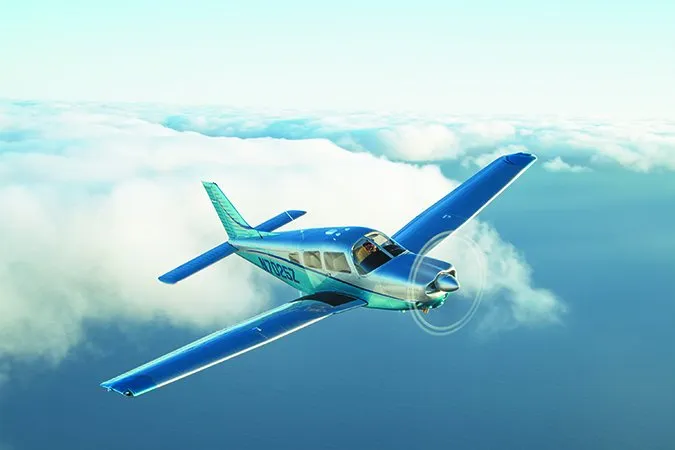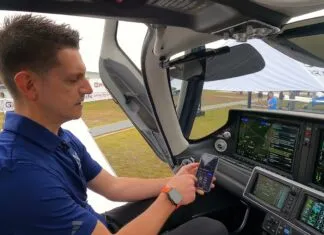At one time, a normally aspirated 200-HP Piper Arrow was our go-to aircraft for travel around the Northeast and occasional hauls from Connecticut to the Carolinas. While the Arrow lacked the excitement of a Mooney 201, it was stone simple to fly, had reasonable operating costs and most important to our mission—it delivered good dispatch reliability.
Those are compelling traits long recognized by flight schools who swear by them as relatively economical complex trainers. Plus, owners report happy relationships with the Arrow’s combination of useful load and range. Through longevity and numbers, it may have replaced the Bonanza as the ubiquitous retractable single.
Since it’s little more than a retractable Cherokee, the Arrow is a logical step-up airplane for pilots accustomed to Piper’s fixed-gear four-seaters. Moving from one cockpit to the other, everything will be reasonably familiar, from gauge placement to systems to handling and procedures. That’s no accident, of course: Offering a full line of airplanes was the basic marketing model for all of the major manufacturers in the 1960s and 1970s. As they started out in two-seat trainers, pilots were encouraged to step up into similar four-place, fixed-gear models, then to retractables from the same bloodline.
While the market has changed, the Arrow soldiers on. It’s a relatively ubiquitous airplane, available in many flavors ranging from the original, relatively sedate 180-HP version with its short, stubby wings to a fire-breathing, T-tailed, turbocharged version perhaps best known for heat-management and runway-hogging issues. Even Piper has a bad day. A few quirks aside, though, some version or vintage of the Piper Arrow may be the right airplane at the right time for a prospective owner.
History of the Line
The original PA-28 owes its existence to three pioneering designers, John Thorpe, Karl Bergey and Fred Weick, who were charged with developing an airplane that would compete with the Cessna 172. Introduced in 1962 as the Cherokee 150 and 160, the PA-28 gave Piper a badly needed shot in the arm in the low-end market. Cessna had a runaway success on its hands with the 172, and Piper’s competition—the Tri-Pacer—was downright dowdy by comparison.
The original Cherokee did well, and was soon joined by the 180 and 235, giving Piper a strong lineup of fixed-gear singles meeting many missions. Since all Cherokees share the same basic airframe, the company was also able to realize some manufacturing economies.
By the mid-1960s, Piper began considering the PA-28 as a candidate to compete in the light four-place retractable market, then dominated by Mooney with Beech’s least expensive retractable—the Debonair—costing a third again as much as a Mooney. Cessna had no comparable airplane at all, and Piper’s Comanche would go out of production in the mid-1970s.
Piper folded the gear on its Cherokee 180 and in 1967 unveiled the first Arrow. It was every bit a Cherokee, from the fat, constant-chord Hershey Bar wing to the stabilator. The base price was $16,900, some $1350 less than the Mooney M20C Mark 21 (according to the Aircraft Bluebook Price Digest). However, the average equipped price of an Arrow, as delivered, was actually about $2000 more than the Mooney. A Cherokee 180 from the same year had a base price of a mere $12,900.
The PA-28R-180 came with a constant-speed prop turned by a Lycoming IO-360-B1E engine. The new retractable gear was electro-mechanical (compared to Mooney’s distinctive manual “Johnson bar” arrangement), and had a unique feature designed to enhance safety: an auto-extension mechanism that would lower the gear if the airplane slowed below a certain airspeed. More on the Arrow’s gear system in a moment.
The original Arrow compared we’ll with the Mooney in some departments, such as roominess and cost, but fell short in terms of speed. Cruise was pegged at 141 knots, compared to 158 for the Mooney. Still, the Arrow was considerably faster than the carbureted, fixed-gear, fixed-prop (but otherwise identical) Cherokee 180.
After two years and sales of almost 1100 airplanes, Piper came out with a 200-HP version of the Arrow. An extra $500 bought pilots a Lycoming IO-360-C1C engine, a few knots and a 100-pound boost in gross weight, though that was eaten into by a 79-pound increase in empty weight. The -C1C engine was more costly in other ways, too—it had a 1200-hour TBO, compared to 2000 for the 180. That short TBO has since been lengthened by fitting new exhaust valves, and it’s highly unlikely that any of the 1200-hour mills remain. The 200’s TBO is now also 2000 hours.
The 200-HP Arrow was sufficiently more popular than the 180 that the latter was dropped in 1971. Starting with the 1972 model year, the airplane was redesignated the Arrow II. Its fuselage was stretched five inches, providing more rear-seat room; its wingspan increased 26 inches by widening the Hershey Bar design and the stabilator’s span increased. This allowed 50 pounds more gross weight, and the addition of the long-awaited manual gear-extension override. Thanks to larger bearing dowels, the old 1200-hour TBO was boosted to 1400 hours. The next year marked the development of a redesigned camshaft and another TBO increase—to 1600 hours.
In the mid-1970s, Piper revamped its line of metal singles (leaving the Super Cub alone), starting with the bottom of the PA-28 line. Beginning in 1975, the airplane that had been the Cherokee 140 became the Warrior, sporting a new, semi-tapered wing of higher aspect ratio than the familiar Hershey Bar and a 150-HP engine. This new wing found its way onto the Arrow in 1977, creating the Arrow III. In that same year, Piper made a turbocharged version of the Arrow. More on this variant in a moment.
The new wing improved performance somewhat, most notably in terms of glide. It also gave pilots a healthy 24-gallon increase in fuel capacity.
The Arrow III lasted only two model years. In 1979, Piper made a controversial design decision, opting to follow the T-tail design fad. This was dubbed “Arrow IV.” Predictably, performance suffered. Like many T-tail airplanes, the Arrow IV flies differently than Arrows with conventional tail feathers. The T-tail, depending on airspeed, is either very effective or far less effective than a conventional tail (which isn’t as prone to abrupt transitions between different flying regimes). This occurs because the stabilator sits up out of the propwash, and so is less effective at low airspeeds. Many pilots complain that the Arrow IV has squirrelly low-speed performance, with a tendency to over-rotate on takeoff. Others, who don’t try to fly the Arrow IV like the earlier models, look more favorably upon the T-tail. Regardless, some who have flown both report the T-tailed version also demands more attention to pitch trim when changing airspeeds.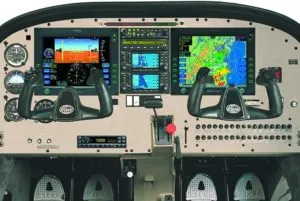
During the general aviation slump of the late 1980s and early 1990s, Arrow production was spotty: The normally aspirated Arrow IV wasn’t built for model years 1983 through 1987; only the Turbo Arrow IV was available. For model years 1988, 1989 and 1990, conventional-tail, normally aspirated Arrows were made alongside T-tailed turbo models. The last three Turbo Arrow IVs were 1990 models; subsequent Arrows through current production all have conventional tails and lack turbos. No Arrows of any flavor carry 1991 or 1993 model designations; this was the time when Piper was on the rocks, searching for a buyer. One Arrow is labeled as a 1994 model.
Piper emerged from bankruptcy in 1995 as New Piper, a moniker dropped in 2006. Today’s version—known simply as the “Arrow,” without any Roman numerals—is essentially an Arrow III, arguably the best of the bunch. The 2012 model’s base price is $414,900, which includes a Garmin G500 avionics suite, but no autopilot.
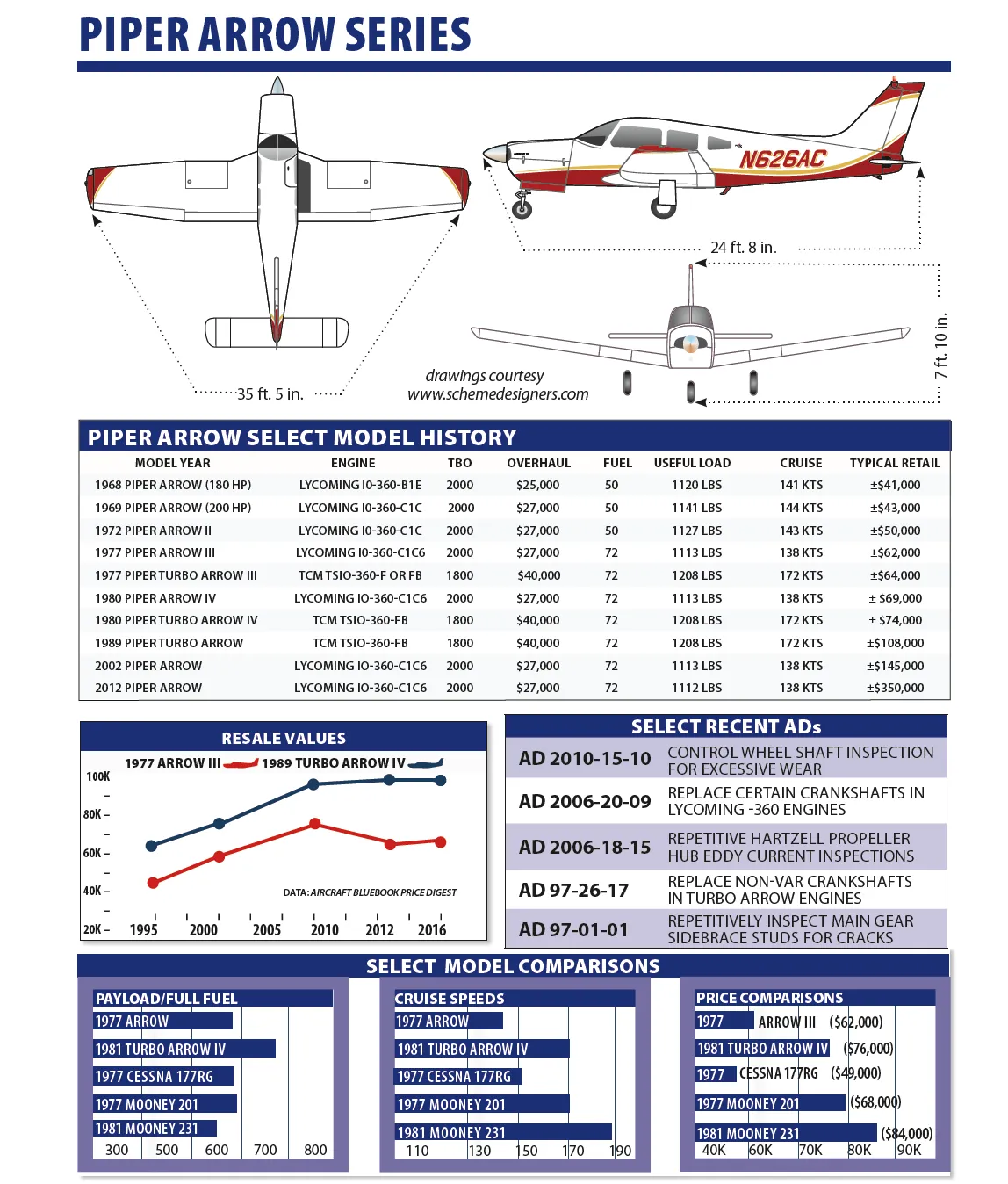
Marketplace
When the Arrow was introduced, its only real competition came from Mooney’s early M20s. Other manufacturers soon realized the viability of the market segment, however, and it wasn’t long before other competitors appeared. Beech’s offering was the rather lackluster (though roomy) Sierra, while Cessna weighed in first with the Cardinal RG, then the Cutlass RG. Rockwell got into the small retractable business with the Commander 112, and Mooney upped the ante with the landmark 201.
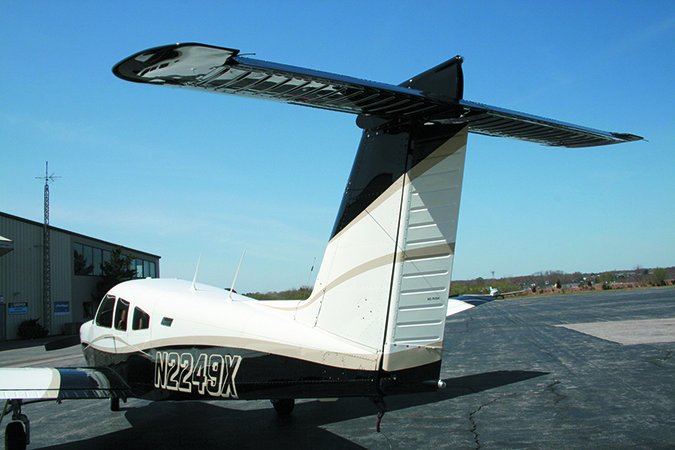
The average equipped prices of these airplanes when new in 1977 (the first year all of them were offered at once) ran as follows: Arrow III: $50,320, Cessna Cardinal RG: $50,095, Rockwell Commander 112: $61,295, Beech Sierra: $53,594 and Mooney 201: $57,420.
The marketplace has declared the Arrow the runaway winner in terms of non-adjusted appreciation: That same 1977 airplane has increased in value by 21 percent. The Mooney is second, up a little over 18 percent. The big loser is the Sierra, which has lost considerable value. It’s worth noting the used marketplace doesn’t like the T-tailed Arrow much, either: A 1979 PA-28RT-201 has not yet recovered its new average equipped price, while a 1978 Arrow III is worth about 10 percent more than its new cost.
The Mooney runs away from the rest in speed and efficiency, which have great value. This is food for thought, since the Arrow is no faster than, say, a Grumman/AGAC Tiger, an airplane that delivers this performance on 20 less horsepower with a fixed-pitch prop and fixed landing gear. It costs about 15 to 20 percent less to buy, and less to maintain.
Performance/Handling
The 200-HP Arrow is an unremarkable performer; the 180-HP version is even less remarkable. Cruise speeds range from 130 (180-HP) to 143 knots (normally aspirated 200-HP T-tail) and as high as 170 knots for a turbocharged version flown in the teens. The normally aspirated Arrows generally burn 9 to 12 GPH, while the turbocharged versions drink about 14 GPH when pushed. A Cessna Cardinal RG, Cutlass RG or Grumman Tiger will go as fast, while burning less fuel. And a Mooney 201, on the same fuel, goes the fastest. Still, the Arrow has a roomier interior than all but the Cardinal, and its useful load is the greatest: 1200 pounds.
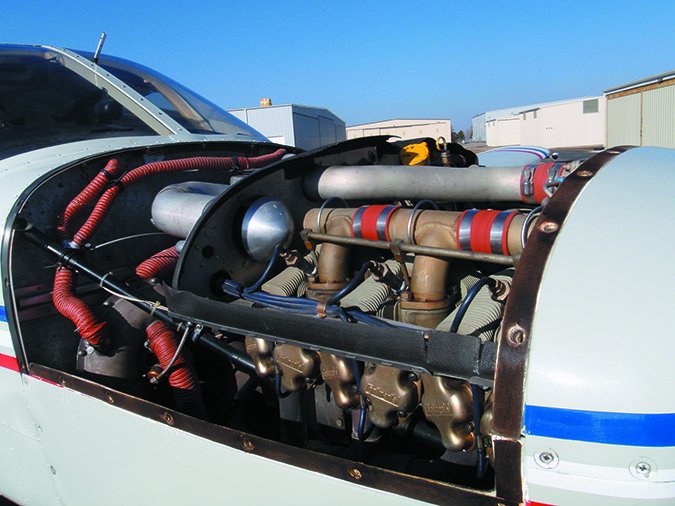
The first two Arrows had somewhat limited range, thanks to their 48-gallon fuel capacity. Beginning with the taper-wing Arrow III, 72-gallon fuel tanks eliminated that problem. Taper-wing Arrow owners report as much as 6.5 hours’ endurance, while Arrow II owners sometimes wish for larger tanks.
The Arrow handles much like any PA-28, which is to say it’s fairly benign. Stalls are a non-event. The wing loading is lower than higher-performance retractables like the Bonanza/Debonair and Mooney, which means a less solid ride in turbulence and at lower speeds. However, that’s also a benefit during landing. Owners report few vices.
Climb performance is competent, but unremarkable. The Arrow is not a STOL airplane, but it doesn’t eat up runway, either. During letdowns, the Arrow’s gear serves as an effective speedbrake. The gear extension limit is close to the cruise speed (which really says more about the cruise speed than it does about the gear), so descents aren’t the problem they are in slick airplanes like the Mooney.
Interior
The Arrow’s interior is quite comfortable. Piper deserves mention for its seat design in later aircraft, which have a crashworthy S-tube design meant to progressively collapse and absorb energy during an impact. This same basic design is used in the JAARS bush-plane seat. Piper also gets crashworthiness kudos for installing a thickly padded glareshield.
Heating and ventilation are both quite good, unlike some other airplanes in the class, with lots of overhead and floor vents. Egress is not the best; we don’t like the single cabin door, especially when compared to the double-doored Cardinal RG, Cutlass RG, Commander 112 and the Beech Sierra. Further, the double-latch system can confuse passengers, particularly in an emergency: Be sure to brief them.
Piper chose long ago to put the engine gauges near the power controls, which makes a certain amount of sense except when setting and monitoring power on takeoff. We’d rather see the gauges up in the pilot’s line of sight where they’re hard to miss.
Gear, Turbo Troubles
The Arrow’s automatic landing gear extension system was intended as a safety feature; Piper touted the Arrow as the perfect airplane for pilots transitioning to retractables. Many pilots and insurance underwriters embraced the “foolproof” gear system, with some insurers even assigning lower rates. Alas, the system isn’t perfect, and didn’t prevent landing gear-related mishaps in the Arrow.
Also the Arrow’s automatic gear extension system is a good example of how safety features can spawn new hazards even while eliminating old ones. In high-power, low-airspeed configurations, the system could either delay retraction or lower the gear at an unwanted time.
Then there are Arrow pilots who lose their engines and decide to ditch with the gear up. Unfortunately, some forget to override the automatic extension system. The gear plops out seconds before splash-down—sending the Arrow head over heels. Savvy Arrow pilots learned early on to “pin”—override—the system to keep the gear retracted when doing any sort of max-performance work.
There is a second pitot tube, located on the left side of the cabin, for the automatic gear system. If it is equipped with pitot heat, it should be checked along with the primary pitot tube before flight, as more than one pilot making a high-speed, IFR descent through a thin stratus layer has had the gear suddenly extend because that second pitot froze over.
There were enough “misunderstandings” by mid-1987 that Piper, then owned by Lear-Siegler, ordered the system deactivated because of concern over liability suits. It sold kits to do so, and told customers it wouldn’t provide parts to repair the existing system. Piper sold 1400 kits.
A year later—then owned by M. Stuart Millar—the company withdrew its deactivation order, provided that pilots “take the necessary actions to assure that any pilots flying these aircraft are fully advised of the system and its proper operation.” In part, Piper was responding to the complaints of irate owners who believed the system worked often enough to be desirable.
When Piper hung a 200-HP turbocharged Continental TSIO-360-F onto an Arrow III in 1977, the combination looked like a perfect match: the world’s premier economy retractable single and a powerplant promising high-tech performance at low-tech prices.
The extra money—the average 1977 Turbo Arrow III went out the door costing around $4600 more than its non-turbo’d sibling—boosted book max cruise speed from 149 KTAS to a whopping 177 at altitude. A new cowling rounded out the deal and announced to the ramp rats your bird was turbocharged.
Soon, however, the engine began earning a reputation as tricky to operate and prone to self-destruction. It didn’t help much when, in 1979, Piper combined its T-tail airframe with the turbo’d engine, even if the powerplant got a different suffix and much-needed TBO extension (from 1400 to 1800 hours).
The result was a handful on the runway: The T-tail’s tendency to encourage overrotation, coupled with the engine’s need for attention on the takeoff roll, meant a busy time, especially on high-elevation fields. On the good side: The engine’s fixed wastegate introduced legions of pilots to the term “bootstrapping.” For pilots transitioning from a normally aspirated Arrow, it was too tempting to run the throttle to its stop early in the takeoff roll, just as one would with the non-turbo’d version.
Do that with the Turbo Arrow, though, and you’d get a red “overboost” light very soon, often followed by your mechanic’s bill for the subsequent inspection. Instead, the favored technique was to run up the MAP to no more than 30 or so inches early in the takeoff roll, then forget about it while monitoring the other engine gauges and keeping the centerline straddled.
When workload permitted—or runway length demanded—and after the system spooled itself up to around 35 inches, a gentle nudge to the throttle gave around 39 or 40 inches, and then the engine likely would boost itself the rest of the way to its 41 inches of manifold pressure limit and off you went.
Alas, the engine wasn’t as bulletproof as Continental intended or Piper hoped. One five-year printout of FAA Accident and Incident Reports for the Turbo Arrow disclosed no fewer than 54 instances of powerplant failures. Furthermore, the engine stoppages weren’t the result of typical pilot errors such as fuel mismanagement, fuel exhaustion, etc. They occurred from failed connecting rods or rod bolts, broken crankshafts and damaged pistons.
Things got so bad that the National Transportation Safety Board in 1985 called for an airworthiness design review of the engine, citing a litany of component failures. Then-FAA Administrator Donald Engen rejected the request.
These days, things have calmed way down with the Turbo Arrow. A recent check of Service Difficulty Reports (SDRs) going back into the 1990s did not uncover any real trends with the Turbo Arrow’s engine, airframe or appliances.
Better: Turbo Mods
One of the reasons for the Turbo Arrow’s recent reliability may be the aftermarket mods available. Two are significant: intercoolers and an automatic wastegate. Turboplus and Airflow Systems offer intercoolers.
At 12,000 feet, the Turbo Arrow has a fairly low critical altitude—the max altitude at which the engine will develop its rated horsepower. Owners say they get a higher critical altitude with the intercoolers, along with lower operating temperatures.
Meanwhile, in an effort to prevent bootstrapping on the Turbo Arrow and other aircraft with the TSIO-360 engine, Merlyn Products has taken an even more dramatic step and come up with an automatic upper deck controller that looks like the answer to a prayer for Turbo Arrow owners. It increases the critical altitude by 5500 feet while boosting cruise climb and speed slightly, and lowering CHT and oil temperatures significantly.
The ostensibly nifty benefits of this system are much lower turbo speeds, lower engine RPM settings at all altitudes and generally allowing lower engine operating temperatures.
Clubs, More Mods
A variety of mods are available for PA-28Rs, from the usual flap and gap seals (Knots-2U) to shoulder harnesses (B.A.S. Inc.) to the high-spiff-factor LoPresti cowling. Speed-brakes can be had from Precise Flight, though the Arrow doesn’t really need them.
As with any personal airplane, we strongly recommend joining a type club. Their expertise can save real money when tracking down common problems. The Piper Owner Society is an excellent one.
Arrow Accidents: Engine/Mech
Piper’s Cherokee Arrow series airplanes established a reputation early on as “Just the facts, Ma’am” plain vanilla airplanes that were reliable and easy to fly. Our review of the 100 most recent Arrow accidents didn’t give us any reason to argue with that rep. We came away believing that Arrows seldom let their humans down—their humans more often let them down.
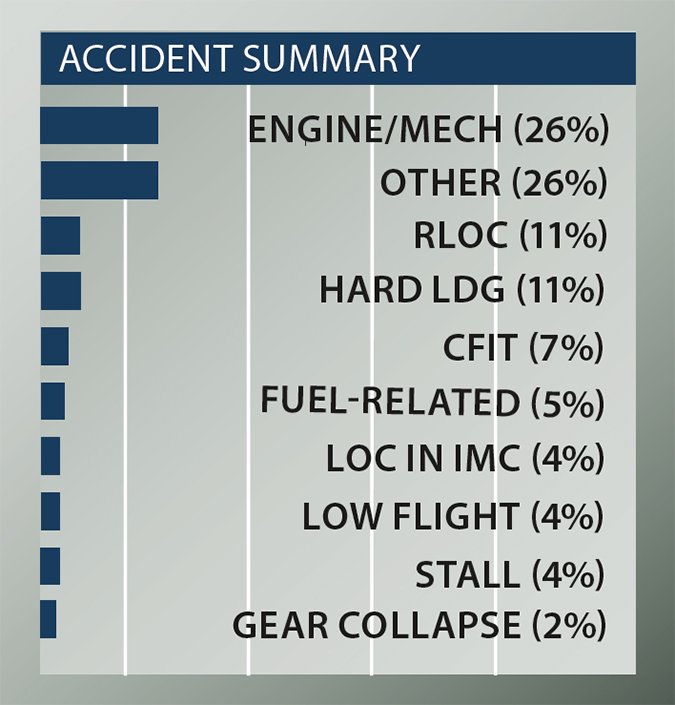
Tied with “other” (more about that in a moment) for the most common initiator of Arrow prangs was the pigeonhole topic of “engine/mechanical.” The vast majority of those events were due to maintenance malpractice, most commonly improper cylinder installation or repairs to the fuel or oil system. Three owners decided to install oil quick drains on airplanes on which the installation wasn’t approved. They each found out why on the subsequent flight. The nosegear hit and opened the quick drain, leading—not long after—to oil starvation and engine seizure.
There were only 11 runway loss of control (RLOC) accidents on takeoff or landing (mostly landing), a tribute to well-designed landing gear and the Arrow’s overall good manners on the ground. However, there were also 11 hard landing events. Two were reported only sometime after the fact—the damage was discovered on a later preflight. In both cases it was impossible to determine who had been flying the airplane when the damage was incurred. (“I swear, it wasn’t me!”)
We also noted only one gear-up landing to a stop, perhaps a record for retractable gear airplanes and a tribute to the automatic gear extension system on many Arrows. One pilot reported that as he touched down he suffered a prop strike and the airplane seemed to be handling strangely, so he pulled up—only to then hit so hard he drove the right main gear through the top of the wing. The investigator noted that, because of the gear geometry, it’s impossible to have a prop strike with the gear down—yet the runway and prop showed definite evidence the two had become intimate. It was determined that the pilot had not been completely forthcoming in his description of the event—he’d actually forgotten the gear, pulled up when the prop hit the runway, extended the gear and then performed the hard landing.
The automatic gear extension system was a player in two high density altitude takeoff accidents. Neither pilot understood that the system would keep the gear down until it sensed enough airspeed—which wasn’t reached. Neither knew that the solution is to use the override feature on the system and get the gear up so the airplane will accelerate and climb. One pilot landed on the rising terrain ahead of him; the other thought the engine wasn’t making power so he slid the mixture control to rich—and then it really wouldn’t make power at that altitude. He damaged the airplane in the subsequent forced landing.
We considered the majority of the 26 “other” accidents to fall in the category of stupid pilot tricks, including such things as retracting the gear on rollout, trying to take off on runways too short for the weight of the airplane and conditions, VFR into IMC, doing aerobatics until the airplane breaks up in flight and starting at high RPM and not knowing how to use the brakes.
Owner Comments
When I was looking to step up from my Cherokee 140 back in 2004, I thought the Arrow would be the ultimate transition. It looked to have reasonable performance, good handling and might be relatively inexpensive to maintain. It just so happened that a friend had one and invited me to fly along on a cross-country trip to the Midwest and back to Connecticut. This opportunity allowed me to fly and see firsthand how we’ll this airplane performed. Needless to say, I was hooked.
A search for an Arrow proved challenging as I was looking for a turnkey aircraft that had pristine paint, a low-time engine and solid avionics. My search finally revealed a 1979 Piper Arrow IV. I had no experience with the T-tails, but heard rumors that the aircraft required extra handling to fly. I decided to fly it with the owner’s CFII and put it through the paces. I learned that most of the T-tail rumors are simply that—rumors.
My Arrow IV came nicely equipped because the previous owner did a complete refurbishment on the aircraft in 2001. It had custom paint, a high-end leather interior and a full Garmin suite of avionics coupled to an S-TEC 55X autopilot. There was little not to like. Better yet, the owner replaced the old engine with a factory remanufactured engine, which had 380 hours on it when I picked up the aircraft.
Fast-forward to 2016 and I have over 1200 hours on the engine and all has been good. The Lycoming IO-360 is fairly bulletproof. I use CamGuard additive and Phillips 20-50 oil blend to reduce potential corrosion. I had one sticky valve that had to be lapped, but that has been it.
Over the years I have kept up with upgrades including changing the exterior landing lights to HIDs, updating avionics by adding a Sandel SN3308 EHSI, a Garmin 796 GPS, the VoiceFlight system and most recently, trading out the transponder for a Garmin GTX345 all-in-one transponder for ADS-B compliance. Since the aircraft is hangared, the paint and interior are still like new. This has also reduced the potential for exterior corrosion—a big concern.
Twelve years of ownership has proved interesting, with a few major surprises. I went through three landing gear pumps over the first five years of ownership. These were clearly substandard pumps and all has been good since. The aircraft is also equipped with the Piper Aire air conditioning. The headache with the system is that it utilizes a thin alternator belt, which has to be monitored. Any slight bit of wearing or twisting requires immediate replacement. I had two sudden belt failures over the last 12 years and it’s a major hassle because the prop needs to be pulled to change the belt. Luckily, I have a good A&P who knows how to install, adjust and properly align the belt. Last, the idiotic AD for mandatory crankshaft replacement was completed at a $13,000 expense to me.
I average around 50 to 60 hours of flying time per year, flying up and down the East Coast. Annual inspections are around $2300. Insurance costs have remained around $1700 for a $125,000 hull value and $1 million smooth policy. I’m a 2200-hour instrument pilot. The total cost to keep the Arrow flying a year is around $9000, including insurance, engine reserves, hangar lease, annuals, upgrades and navigation databases. This is before any fuel costs.
Typical groundspeeds are 139 to 142 knots while sipping 8 to 9 GPH at altitude. I tend to run lean of peak EGT when able, while monitoring the temperatures on the engine analyzer.
Overall, the aircraft meets my mission needs and is a solid performer with decent speeds.
A. Elwood
via email
I have a 1969 PA28R-200 Arrow. Its original baby-blue paint has held up we’ll since the aircraft has been hangared for most of its life. It currently has 3400 hours on the airframe and 1400 hours since its first engine overhaul.
I’ve upgraded the avionics with an S-TEC autopilot with digital steering, altitude hold and trim command, plus the autopilot is interfaced with a Garmin GNS530W. I also have a Garmin GDL88 ADS-B system with Flight Stream 210 for wireless data interface to my iPad. There is also a Garmin GPSMap396 with XM satellite weather that sits in a Air Gizmo dock mount, a PS Engineering PMA450 audio system, plus a Sandia SAI-340 electronic attitude indicator. I monitor the engine and fuel burn with a JP Instruments EDM700 and a FS450 fuel computer.
Maintenance issues are few, with the most expensive being propeller and governor replacement a few years ago. Oil consumption is approximately one quart per 8 to 10 hours. I have a good handle on fuel burn thanks to the FS450, which averages 8.7 GPH at my normal cruise altitude of 12,500 (I live in Colorado).
True airspeed has consistently been 140 knots over the 15 years I have owned the Arrow, while the average cost for annual inspections has been about $2100.
Jim Torley
via email
I’ve enjoyed my 1973 200-HP Arrow II with air conditioning since early 2001 and plan to keep it many more years. It is a good all-purpose airplane, from the $100 barbeque, to frequent 200-NM runs to the beach, to the occasional 500- to 1000-NM trip to Canada and the Bahamas.
With 48 gallons of usable fuel (burning 9 to 11 GPH), I flight plan for 450-NM IFR legs, unless I anticipate dodging thunderstorms. It trues out at 169 MPH.
My airplane came with LoPresti wheel covers that offer a speed increase, plus they are cheap. What would be moderate turbulence in my old Skyhawk is light turbulence in the Arrow, determined when I flew the Skyhawk to a buddy’s airport several times and then climbed into his Arrow for comparison.
The big and expensive problem areas are air conditioning and landing gear. Everything else is trivial and relatively cheap. I leaned toward the Arrow after I lost my Skyhawk to hail damage because of its range and air conditioning (it’s one of the few lower-end planes with air conditioning).
A friend with a Cirrus gave me grief on a flyout because she beat me by seven minutes after departing from the same airport. I reminded her that hadn’t I dropped the air conditioning condenser into the slipstream, I’d fly 8 knots faster. She never ribbed me about speed again.
The biggest—and unsafe—problem with air conditioning in single-engine Pipers before about 2001 is that Piper shrank the alternator belt from 5/8 inches to 3/8 inches in order to make space for the compressor belt. This isn’t sufficient. Even after following Piper’s service bulletin to precisely align the pulleys, I still shredded alternator belts every 10 to 15 flight hours—not fun in night IMC. If the belt is twisted, it probably will shred and depart the aircraft on the next flight.
The solution, short of modifying the plane to change to 5/8 inch pulleys, brackets and belt or suffer 95- to 100-degree summers without air conditioning here in the South, is to spend north of $4000 on parts and about eight hours of your mechanic’s time to replace the pulleys, alternator mounting bracket and a belt to modify it to the standards Piper used in 2001 and models beyond.
Piper will sell a modification kit for $500 to $700 more, but I obtained a parts list and searched for the cheapest vendor for each. Seven years later the alternator belt is fine. It was we’ll worth the cost and effort.
The nosegear trunion suffered a metal fatigue failure in 2008, horizontally cracking through about half of it, resulting in collapse when I attempted takeoff from a sand and dirt runway due to the nosewheel twisting 90 degrees to the right when turning onto the runway. This caused an abrupt engine stoppage when the prop stuck in the ground. AIG insurance was wonderful.
A friend’s Arrow suffered a similar main nosegear failure. I suggest to carefully inspect the gear. Recently, the nosegear didn’t come down on the first attempt. I swapped the landing gear status lamps, recycled the gear and it was down and locked.
My mechanic found the gear indicator adjustments set at maximum travel, suggesting that we might even get a green indication when the gear is not actually down and locked. He completely disassembled the gear and found many worn bushings and such needing replacement. This apparently had never been done in its 43 years. He recommends this procedure every 10 to 15 years, so be aware of it when evaluating an Arrow for purchase.
Another concern is corrosion around the throttle pushrod where it enters the guide tube in the engine compartment. I discovered this when I was unable to advance the throttle from idle when attempting an engine start in Canada.
I’m lucky I didn’t pull it to idle on my previous night IFR flight. When I returned home, I had the throttle, mixture and prop cables replaced.
Last, being fuel-injected, the Arrow can be difficult to start when the engine is hot, especially after quick-turn refueling in the summer. An FAA- and PMA-approved Slick Start magneto booster system (the Slick Start integrates solid-state electronics with conventional ignition hardware to deliver optimum spark energy for improved engine starting) greatly helped, but it’s not a cure-all. As a rule, if the engine doesn’t fire in two start attempts, proceed to a flooded start procedure.
I think my Arrow has suffered far more mechanical problems than most. Still, I recommend the airplane, but suggest having a competent mechanic who is familiar with the Arrow spend the time needed to maintain it properly.

